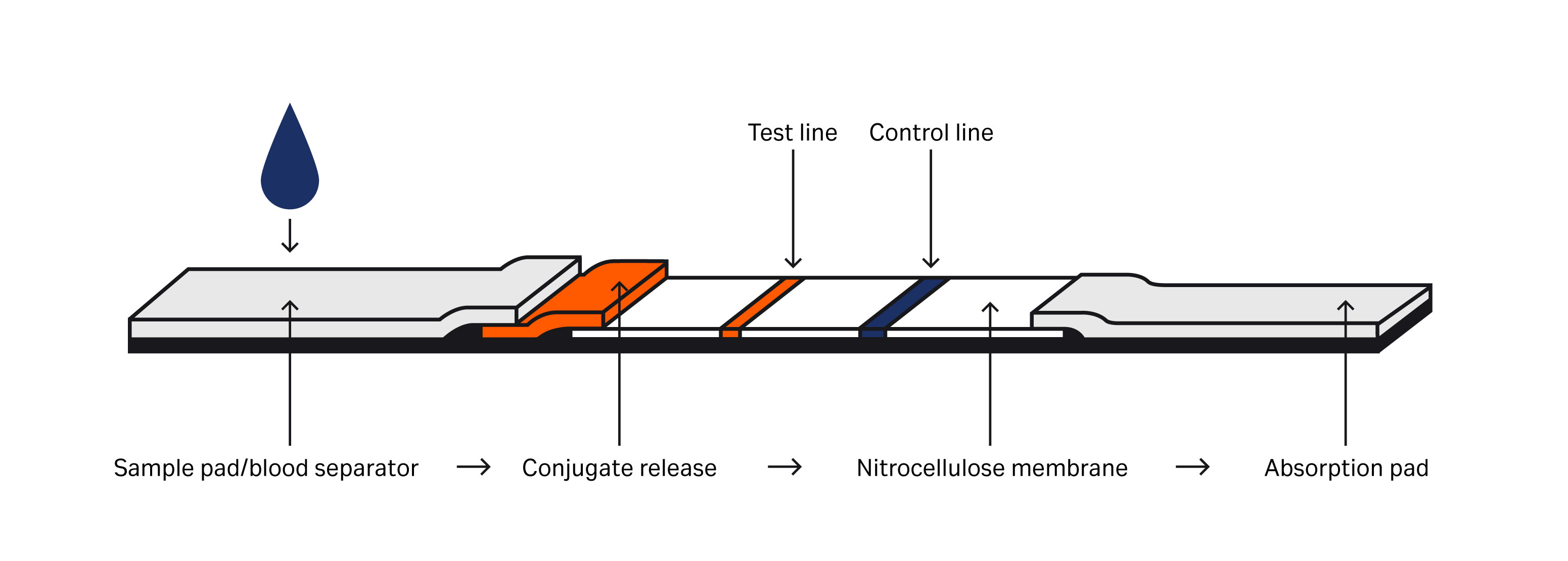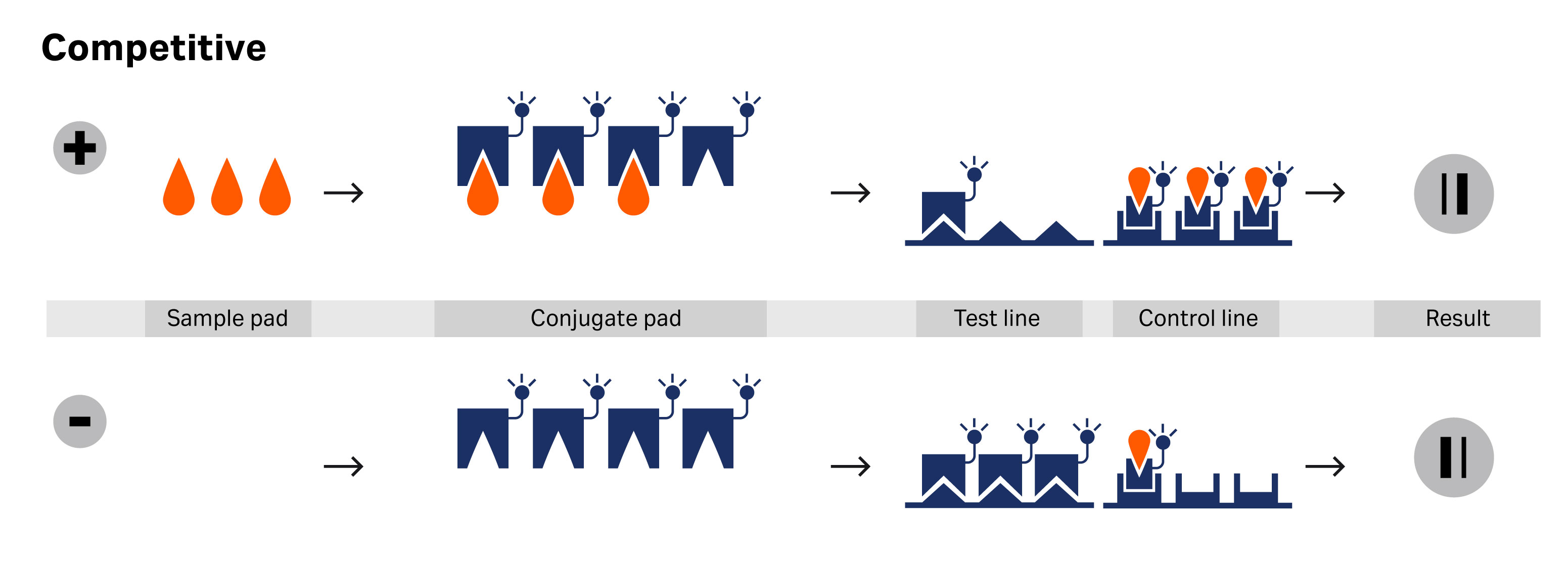Choosing the right format is a critical preliminary step in lateral flow assay development. This blog explores the sandwich and competitive LFA formats.
Sandwich or competitive format: which is right for your LFA?
Congratulations! You’ve discovered an important biomarker that could become the target molecule in a lateral flow assay (LFA). Let the assay development begin!
Choosing the right format is a necessary preliminary step in lateral flow assay development. Here we explore the sandwich and competitive LFA formats, how they work, and which is suited to different target molecules.
How does a lateral flow assay work?
An LFA starts with the application of a liquid sample (often urine, blood, or saliva in diagnostic tests) onto a sample pad. The liquid then travels laterally through a conjugate pad and onto a test membrane. While passing across the different parts of the device, the sample encounters reagents that help to detect the presence of target molecules in the sample. These can be antigens, drug substances, or other proteins (Fig. 1).

Fig 1. In an LFA, the sample flows through a series of pads and membranes, which contain detection reagents.
The conjugate padThe conjugate pad contains a labeled detector reagent, usually an antibody, that’s released into the sample as it flows across the pad. The label is a colored or florescent nanoparticle that’s bound to the antibody and will show up when passing over the test or control line. The antibody is specific to the target molecule. As the sample flows across the conjugate pad, the reagents will be released into the sample and bind to the target molecule if it’s present.
The test membrane is the heart of the assay, and it usually consists of a nitrocellulose (NC) membrane that contains fibers coated with a surfactant. The membrane is also the part of the device that displays the test result, and it plays a central role in determining parameters such as speed, sensitivity, and specificity of the test.
Test line and control line- The test line indicates the presence or absence of the target molecule in the sample.
- The control line indicates that the test has returned a valid test result, and that the test has not been degraded by, for example, improper storage.
The test and control lines contain ligands that will bind selectively to the target molecule or the antibody in the detector reagent. The nature and location of the reagents on the membrane vary depending on the target and the type of LFA.
The final component of the LFA is the absorption pad. This simply absorbs excess liquid as wicking action continues to draw the sample through the nitrocellulose membrane.
Sandwich or competitive? The basics
There are two main formats to consider: the sandwich LFA and the competitive LFA. Your target molecule will be key to determining which LFA format is most suited to your assay.
- The first type of LFA assays is a non-competitive, or sandwich test. It’s used for macromolecular analytes with two antigen binding sites: it has binders that attach to the target and do not interfere with each other. If the target is present in the sample, there will be an increase in the signal at the test line. A well-known example of a sandwich test is a pregnancy test.
- The second type is known as a competitive test. It’s used for small molecule analytes that don’t have two binding sites. Since you can’t bind more than one binder to the target molecule, you need to use a test line that contains your target molecule. If the target is present in the sample, there will be a decrease in the signal at the test line. An example of a competitive test is one used to test for drugs of abuse.
As shown in Figure 2, in a sandwich-type lateral flow assay, the conjugate pad contains antibodies that are conjugated to a detector label. These antibodies will bind to a specific region (or epitope) of the target in the sample. The conjugate pad also contains labeled control antibodies. As the sample passes through the conjugate pad, the target binds to the detector-conjugated antibodies — also known as labeled antibody — and flows towards the test line on the membrane. The control antibodies will also get carried along with the sample.

Fig 2. Illustration showing how a sandwich LFA works.
As the sample encounters the test line on the membrane, which contains immobilized ‘capture antibodies’ that bind to the target using a different epitope to the labeling antibody, the test line captures the passing target-antibody-label conjugates. This ‘sandwiches’ the target between the capture antibody and the labeled antibody. The accumulation of label on the test line can be detected digitally or be visible to the user as a colored line on the membrane in case of a positive sample.
After the test line, the sample encounters the control line containing capture antibodies that bind the labeled control antibodies. This line becomes visible regardless of the presence of a target.
The sandwich format is more favored towards larger molecular weight analytes, as experience shows it does not work as well for smaller molecular weight substances.
Competitive assaysAs illustrated in Figure 3, in a competitive assay, the conjugate pad contains labeled test antibodies that bind to the target and move with the fluid flow, similar to a sandwich assay. But molecules on the test line contain a binding site that mimics the target, which means that only unbound labeled antibodies will be captured. As a result, the test line signal becomes more intense with lower concentrations of target molecule in the sample.
The control line in a competitive assay contains capture antibodies that bind all labeled test antibodies, whether or not they are bound to the target. A line will appear regardless of the presence of the target in the sample, but signal intensity will be higher with increasing concentrations of the target.

Fig 3. Illustration showing how a competitive LFA works.
Summary
Choosing the right LFA format to detect your target molecule is an important early step in LFA development. Explore our knowledge center to learn more. We also offer diagnostic assay development services to help you get from idea to commercialization faster and more efficiently.
For samples or to contact a specialist